Benefits of Investing in a Top Rated Whole House Water Softener and Filter Combo
Water softeners are made specifically to lower the amount of minerals in hard water, like calcium and magnesium. Appliances and plumbing equipment benefit from this. While this can help lessen the harm that hard water causes, it does not improve the flavour of tap water or get rid of other contaminants that are present in the household supply.
Installing a top-notch whole house water filter can help in this situation.
Nothing compares to having the best whole-house water softener and filter combination. You may benefit from better-tasting, healthier water while also safeguarding the plumbing and appliance systems in your home with the correct dual system in place.
To assist you in making the best decision for your home, we will be going through the best whole house water filter and softener combo in this article.
Best Whole House Water Filter and Softener Combo
Springwell 2 in 1 Filter + Salt Softener Combo System OR SpringWell Water Filter and Salt-Free Water Softener
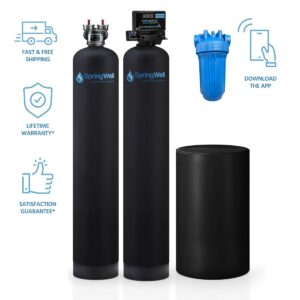
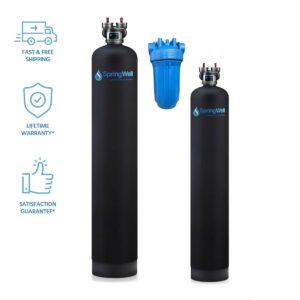
The SpringWell 2 in 1 Water Filter and Salt Softener OR the Salt-Free Water Softener, which is a highly effective whole house water softener/conditioner and filtration system combo, is our top selection for city water.
The SpringWell 2 in 1 Water Filter and Salt Softer has an all-in-one design, unlike the SpringWell Water Filter and Salt-Free Water Softener, which requires you to connect the softener and filter to your plumbing separately.
In contrast to the whole house water filter and conditioner combo system, which uses template-assisted crystallisation (TAC) to create calcium and magnesium crystals that can’t form scale, the whole house filter and salt softener combo system entirely removes calcium and magnesium from water.
Both versions also get rid of pesticides, herbicides, volatile organic compounds (VOCs), chlorine, and chloramine.
The space-saving single-unit design of the SpringWell 2 in 1 Water Filter and Salt Softener makes it less large and unwieldy than some of the combo filter/softener systems on this list. However, if you purchase the SpringWell Water Filter and Salt-Free Water Softener, you are not eligible for this benefit.
You have a choice of a water softener (the most compact version, utilising KDF and salt-based media in the same tank) and a water conditioner (which comes in a separate tank – there isn’t yet a 2-in-1 offering for this configuration). Both work with the SpringWell whole house filter system.
SpringWell 2 in 1 System + Salt Softener
Pros
- The SpringWell 2 in 1 Water Filter and Salt Softener is a wise purchase because it is $500–$1,000 less expensive than other systems on the market with almost identical functionality.
- This water filter and softener combo is the finest if you want to conserve the most space because of its all-in-one design.
- Ion exchange, the most efficient softening technique available, is used by the softener.
Cons
- Plastic is used for some of the fittings.
- Salt needs to be added to the brine tank.
SpringWell Filter + Salt Free Water Softener
Pros
- Can be used with very hard water (up to 81 GPG).
- In our tests, we observed a significant decrease in the production of scale. This whole house filter system and conditioner combination can minimise scale by up to 99.6%.
- uses neither salt nor chemicals, making operation inexpensive.
Cons
- Costly installation kit.
- Does not truly remove hard minerals.
Evo E-3000 Whole House Water Filter and Salt-Free Softener Combo
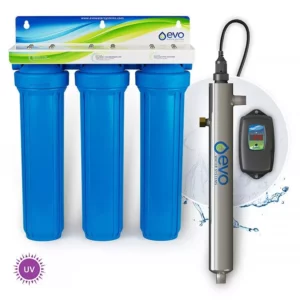
To treat hard tap water that contains chlorine or chloramine, the E-3000 water filtration system and salt-free water softener are combined.
In a single filter housing, the Evo E-3000 includes a sediment filter, a carbon filter, and an eSoft cartridge. To create soft, filtered water, a combination of filtration, adsorption, and template-assisted crystallisation is used.
In this system, the carbon filter significantly decreases chlorine, chloramine, and other organic contaminants while the sediment filter gets rid of dust, rust, dirt, and other things. The eSoft conditioning cartridge keeps beneficial minerals while preventing the development of scale.
Your entire home will have significantly cleaner water thanks to the incredibly cost-effective yet strong filter-softener combination; certainly worth looking into! 5 stars. You may test the system risk-free because the Evo E-3000 is also covered by a lifetime warranty and a 120-day satisfaction guarantee.
Pros
- We adore how easily all three filtration and softening cartridges can be combined in one filter housing. It greatly simplifies installation and maintenance.
- We were delighted by the Evo E-3000’s flow rate for a cartridge filtration system. The system has a maximum flow rate of 15 GPM and is intended for households with up to 6 bathrooms.
- With the help of this Evo Water Systems model, the quality of our drinking water supply significantly improved. We observed a decrease in scale around our home as well as a fresher, chemical-free taste in our filtered water.
Cons
- In a tank-based alternative, the media need replacement less frequently than the cartridges do. Annual replacements for the sediment and carbon filters are required. The eSoft cartridge never needs to be changed, which is wonderful news.
- The Evo E-3000 can only purge the most fundamental, typical pollutants from city water. The filters aren’t specialised enough to get rid of things like fluoride and arsenic.
Springwell Well Water Filter and Salt Based Water Softener OR Salt-Free Water Softener
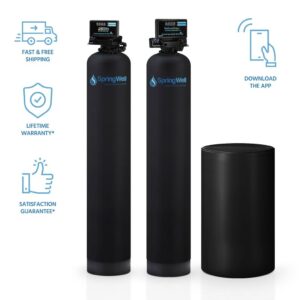
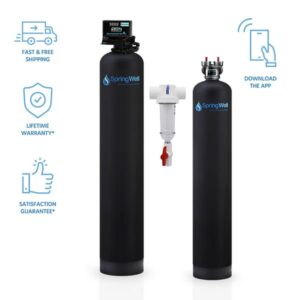
The WSSS or WSSF series is probably the best choice if you use well water. They are ideal for iron, manganese, hydrogen sulphide (which gives off a rotten egg smell), or any combination of the three, in water.
The air-injection well whole house filter is used by both of SpringWell’s combo well water systems. The sulphur, iron, and manganese are oxidised and removed by this single-tank system using an air pocket. The salt-free conditioner or salt-based softener tank from SpringWell are both options for the air injection system.
For the majority of well water supplies with a higher hardness level, the salted system is advised.
Your water will also go through a softening stage in addition to filtration. In reality, only the WSSS combination employs a “true” salt-based water softener, whilst the WSSF configuration uses a salt-free water conditioning device. However, the latter won’t remove any hardness minerals from the water while significantly reducing scaling.
SpringWell stands behind both combo units with a lifetime warranty against all defects and a six-month money-back guarantee.
Whole House Filter and Salt Based Water Softener
Pros
- This SpringWell model improved our water quality the most out of all the well water whole house water filter system and softener/salt-free water conditioner combo systems we tested. After installing this system, our water was clean in terms of appearance, odour, and flavour.
- Ion exchange, the best softening method, is used by the SpringWell Salt Based softener.
- The SpingWell salt-based softener and air injection system combination is perfect for you if your water is extremely hard. When we used this combination on our well water supply, the amount of limescale was immediately reduced.
Cons
- Given how pricey this SpringWell system is, some people may not be able to afford it.
- Two separate tanks are required, which necessitates a large unit. There is no setup that is all-inclusive.
Filter For Home and Salt-Free Water Softener
Pros
- We appreciated how the independently operating salt-free softener and the water filtration tank both employ automatic electronic control valves that automatically backwash on a predetermined schedule and don’t require manual intervention.
- With its ability to prevent up to 99.6% scale, SpringWell’s conditioner is among the most effective salt-free softening solutions available.
- For this system mix, you won’t need to spend money on salt or filter replacements.
Cons
- Another pricey choice, the SpringWell model might be beyond of reach for certain consumers.
- Again, this unit is quite large because it is made up of two tanks.
SoftPro Elite Water Softener for Well Water + Iron Master AIO Water Filtration System
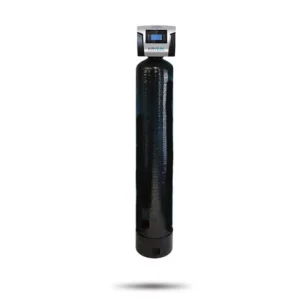
The SoftPro Elite Softener + Iron Master Water Filter is the best whole house filter set available for softening and purifying well water with a high iron level. Up to 30 PPM of iron and up to 5 PPM of sulphur can be filtered out of the water by the system, which also softens it.
Ion exchange and air injection are used in this salt-based softening system to remove up to 30 PPM of iron from water and hard water minerals, respectively. With efficiency in mind, the SoftPro Elite has a high-flow control valve that can be adjusted to meet your softening requirements.
The SoftPro Elite performs best when used in conjunction with the Iron Master filter since it is also very effective and has a control valve that maintains high flow rates.
The Iron Master whole house filter system is available in three sizes: 1.0 cubic foot, 1.5 cubic foot, and 2.0 cubic foot. Additionally, the SoftPro Elite is offered in a range of grain capacity capacities, ranging from 24,000 to 80,000.
Pros:
- With features like a 15-minute “recharge,” which adds a little amount of more salt to the resin if more is needed before the planned regeneration, this SoftPro model is among the cleverest water softeners we’ve tested.
- There aren’t many other water filters that can soften water in the same system while removing up to 30 PPM of iron.
- This system combination will effectively treat hardness and iron issues in well water. After installing the SoftPro Elite Softener + Iron Master Water Filter, our iron problems were resolved, and we experienced no additional scale problems.
Cons:
- You’ll need a lot of space in your home to install this whole house water filter system because it is large.
- This system cannot be purchased with a salt-free conditioner, so salt top-ups are necessary.
Crystal Quest SMART Whole House Water Filter + Softener OR Saltless Conditioner
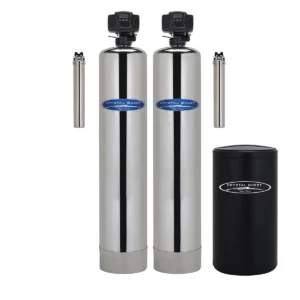
The Crystal Quest SMART Whole House Water Filter and Softener OR Saltless Conditioner is the best alternative we could think of. The softener or saltless conditioner removes hardness minerals or crystallises them to prevent scale formation, while the whole house water filter system uses six stages of filtration to thoroughly remove a variety of impurities.
Both systems are made up of three tanks: a water filter tank, a softening resin and brine tank.
The six comprehensive stages of filtration used by the Crystal Quest SMART Whole House Water Filter include a sediment pre-filter, solid carbon filter, SMART multimedia filter (which includes a standard and catalytic carbon filter and an ion exchange resin), ceramic balls, and tourmaline balls.
Heavy metals, pesticides, herbicides, pharmaceutical by-products, and chlorine/chloramine can all be eliminated from water using this filter softener combination. Additionally, it raises the pH and alkalinity of the water and either uses ion exchange to eliminate hardness minerals (if you choose the softener) or turns them into calcite crystals (if you buy the conditioner).
There are two sizes of the Crystal Quest filter system available for purchase: 1.5 + cubic feet (for residences with up to three bathrooms), and 2.0 + cubic feet (for homes with 2-4 bathrooms). Both the saltless conditioner and the softener are available in sizes ranging from 1,000,000 to 1,500,000 gallons.
SMART Whole Home Water Filter + Softener
Pros
- For those who want to properly treat their water using cation exchange and various filtration media, the Crystal Quest SMART Whole House Water Filter + Softener is the perfect option.
- In our testing, this Crystal Quest model completely reduced limescale buildup by exchanging hardness minerals with sodium or potassium utilising a unique cation exchange resin bed.
- You can purchase this system for a reasonable cost, depending on the system size that you require.
Cons
- It takes up a lot of space because it has two sizable tanks.
- Salt will need to be added to the brine tank on a regular basis.
SMART Water Filter For Whole House + Saltless Conditioner
Pros:
- Hardness minerals are converted into stable nanocrystals by the Crystal Quest SMART Whole House Water Filter + Saltless Conditioner using a salt-free, chemical-free conditioning technique.
- This device provided the most extensive water purification of all the ones we examined. As many as six filtration stages and water conditioning are uncommon in a whole house filtration and softening system.
- The filter and conditioning media have a lifespan of up to 10 years, so you only need to perform minimal maintenance.
Cons:
- Again, because there are no all-in-one configurations, this system is large.
- The conditioner could need pre-treatment if the iron, manganese, or hardness levels in your water are excessive.
Buyer’s Guide For Whole House Water Filter + Softener Systems
Finding it difficult to pick the best whole house water filter and softener combo for your house? We’ve prepared this buyer’s guide section with important factors to look into in hopes that it’ll make your purchase decision easier.
Factors To Consider When Buying the Best Water Softener and Filter Combo
What’s In Your Water Supply
The first step is crucial: you must know exactly what ingredients are in your water. If you don’t know what you need to remove from your water, you won’t be able to choose the system that would work best for you.
For the most thorough results, we advise having your water professionally tested by a state-certified laboratory, particularly if you have a private well. Water safety is the responsibility of the well owner, and this frequently entails installing whole-house water filtration and softener equipment at the main water line.
Depending on the test you select, laboratory testing can cost anywhere from $100 to $250. Numerous laboratories provide packages that test for the most typical pollutants in well or city water. Additionally, testing for particular chemicals that are of concern in your area may cost more.
Based on the harmful contaminants found in your water test, you can select the appropriate type of media combination for your whole house filtration system/softener combination.
If you acquire your water from a municipal source and don’t have the extra money for a laboratory test, look at your water quality report. The trace pollutants found in your water are listed in this report.
Although it doesn’t take into account daily variations in contaminant levels and is unable to reveal which harmful contaminants may infiltrate your water as it travels from the treatment facility to your home, a water quality report can provide you with a complete overview of what’s in your water.
To find the report for your region, use the EPA’s Consumer Confidence Reports tool. Alternatively, to get a general notion of what might be in the water in your area, you might utilise an internet resource like this one from the EWG.
If you are worried about the levels of lead and chlorine in your water, you might want to get an at-home water testing kit. Online, these kits are less than $20. DIY tests are a fantastic place to start, but they won’t offer you the most precise picture of the chemistry of your water.
Types of Whole House Water Filter
Now that you know what exactly is in your water, you can move on to decide which whole house water filter system will work best to help you ensure you get clean, filtered water throughout your house.
- Sediment Filter
Sediment filters for the entire house can be standalone units or a component of a larger whole home water filtration system. Spin-down filters and cartridge filters are the two most popular forms of standalone sediment filters.
- Spin-down sediment filters
Spin-down sediment water filters are a popular choice for well water that has significant silt or sand particles in it. The top of the filter receives water, which spins centrifugally from top to bottom. As a result, the sediment is removed from the water as it passes through the filter.
You will need to flush some spin-down filters on a regular basis to get rid of the sediment. Some of them come with a flush valve. For convenience, some feature automatic flushing. Because they can be flushed, spin-down filters often last longer than sediment cartridge filters.
- Cartridge sediment filters
In whole-house water filters or reverse osmosis filters, cartridge filters with a spun-cartridge or pleated cartridge design are frequently used as first-stage filters.
Water is passed through several layers of spun, melted polypropylene in spun-cartridge filters. The micron level of the filter is highest in the outer layers and gets smaller as you move inward toward the centre. This means that while the smallest particles are removed when water enters the filter’s interior, the larger silt is removed from the outside.
The same micron rating is applied throughout a pleated filter’s entire folded or pleated construction. Pleated filters aren’t quite as effective as spun-cartridge filters because they can only capture particles of a specific size.
- Carbon Media
Granular activated carbon (GAC) and solid carbon block media are the two filter types most frequently used for carbon filtering media.
- Granular activated carbon water filters
A naturally absorptive material, such as coconut shell or coal, is often used to create GAC medium. GAC filters feature a sizable surface area made up of hundreds of microscopic micropores that act as adsorbents to trap pollutants.
GAC filters work best for removing cosmetic pollutants from municipal water, such as chlorine, which impact taste and odour. They can also be used to get rid of some heavy metals and volatile organic compounds (VOCs).
- Solid carbon block filters
Since the solid carbon block media is compact and formed of compressed carbon rather than loose grains, there is a prolonged period of contact between the filter and the water.
Water must navigate a maze of pore sizes as it passes through a solid carbon block filter, which ensures that the widest range of pollutants are eliminated.
According on the filter particle size, some carbon block filters can also remove microbiological pollutants, mercury, arsenic, radon, and asbestos. Carbon block filters are superior to GAC filters at removing heavy metals like lead.
- Oxidation Media
Common well water pollutants including iron, manganese, and sulphur are the focus of oxidation media. A bubble of oxygen is injected into the tank’s top during the air injection procedure. Iron pollutants, for example, are oxidised into their insoluble forms when water is exposed to oxygen.
After being oxidised, these impurities can be removed from the water by filtering. It is customary to employ a resin derived from manganese greensand or a comparable substance to capture impurities as water passes through the system.
The system will regenerate when the resin eventually becomes saturated with impurities, cleansing the medium and resupplying the oxygen bubble.
- KDF Media
KDF, or kinetic degradation fluxion, is a kind of filter medium that causes an oxidation-reduction, or redox, chemical process.
Various types of this zinc-copper alloy medium are offered.
KDF-55 is a good alternative for people who consume municipal drinking water because it removes chlorine. The KDF-85 is better for well water because it removes iron and hydrogen sulphide.
- Combination Media
On rare occasions, you might encounter a filter system that employs a variety of media types to get a more thorough filtration outcome.
KDF-F fine mesh and activated carbon make up the most typical filter media combination. Combining these media improves performance and allows for the removal of a wider variety of dangerous pollutants.
Types of Water Softener Systems
Ion Exchange vs Water Conditioner
Ion or cation exchange water softeners and salt-free water conditioners are the two most popular types of water softeners on the market right now.
Although the outputs produced by the two units are relatively similar, the ways in which they arrived at those findings are considerably different.
- Ion exchange water softeners
Salt is used in ion exchange systems to soften water. Hardness-causing magnesium and calcium minerals are exchanged for sodium ions, which are then discharged into the hard water. As a result, the hardness minerals are totally removed from the soft water.
When the resin bed is fully saturated with hardness ions, salt-based softeners need to renew. Regeneration typically occurs at around two in the morning, when most people aren’t using their water.
- Water conditioners
Water conditioners, an alternative to salt-based systems, prevent scale by using techniques like template-assisted crystallisation (TAC for short). This covers the calcium and magnesium minerals with a dense, crystalline layer that hinders their ability to adhere to surfaces.
Hardness is not actually removed by water conditioners. Instead, they avoid limescale, which is the main issue with hard water.
Whole House Water Filter System Capacity
It’s critical to precisely calculate the capacity your whole-house water filter and softener combination requires.
The capacity of the system determines how long it will operate until regeneration or replacement of the filter medium or resin is necessary (in the case of a salt-based water softener). Water flow rate and capacity typically go hand in hand; the higher the capacity, the quicker the water flow.
You must select the appropriate capacity based on your daily water demand. The filters or softening media may work too hard if you buy a system that is too small for your needs. That means the system will need to regenerate too frequently for salt-based water softeners, which will result in excessive water waste.
The speed of the water flow could harm your pipes if you get a system that is too large for your house. Units that require regeneration might not renew as frequently as they should to clear out the media and stop bacterial development if they have an excessively large capacity.
Water Flow Rate & Pressure
When choosing a whole house water filtration system and softener combo, water pressure and water flow rate are two more crucial factors to take into account.
It’s critical that both systems can handle water quickly enough to reliably supply your entire home with water whenever it’s needed. You shouldn’t see a decrease in water pressure when using several water-based appliances simultaneously, such as a shower and a washing machine.
Pressure ratings for the top whole-house water filters and softeners range from 10 to 15 gallons per minute (GPM).
Initial Capital and Ongoing Maintenance Cost
A single water softener or water filter system costs, on average, about $1,500; but, if you purchase both at once, the manufacturer may provide a discount of $200 to $500.
In addition to the purchase price, the cost of engaging a plumber or handyman for installation should also be taken into account. Depending on the competition in your region, the cost of installing a whole house water filtration system and softener professionally ranges from $150 to $300.
There are a number of recurring costs for whole-house filters to take into account. The majority of filter devices employ cartridges that must be changed every two, one, or six months.
You might buy a water conditioner or whole-house filter system that employs filtration media. Media typically has a lifespan of six to ten years.
The most expensive to maintain are water softeners that employ salt. Every three weeks or so, they need to top off on salt, and while regeneration is taking place, water is lost. Although buying salt in bulk online can save you money, it’s still important to consider these costs when determining which system you can afford in the long run.
Space Availability for Your Whole House Water Filter
Even the best whole-house water softener and filter combination will occupy a significant amount of space in your house. Since you’re installing two units simultaneously, you’ll likely need two batches of tanks and distinct pieces of equipment.
A single tank that performs two tasks at once is present in a few of the filter/softener combinations in this guide, but it is less frequent.
You should ideally have space in your designated installation location for at least two substantial tanks. Since most tanks must be erected vertically, more space is required up and down than on either side. Additionally, you’ll need enough space for maintenance, such as salt top-ups and filter changes, if necessary.
Before looking for whole home filter and softener equipment, I advise carefully assessing the space you have available. The next step is to read the system’s specifications to determine how much space it will require.
Installation & Maintenance
Whichever whole-house filter and softener combination you choose, the installation will always be difficult.
It will be necessary for you to cut into your water line in order to install various tanks, valves, and other technology. In order to send water away from your system for maintenance or regeneration, you’ll also need to install a bypass valve.
Even though installation is rather complicated, manufacturers are getting much better at providing comprehensive, step-by-step installation guidelines and videos that anyone can follow.
After the installation is finished, you shouldn’t neglect upkeep. Depending on the kind of system you have, you may need to do specific maintenance on your whole-house water filter and softener.
The most frequent maintenance is required for whole-house filters with activated carbon filters, like a carbon cartridge made of coconut shells. Activated carbon filter cartridges usually have a lifespan of 6 months.
Systems that use a media bed for whole-house water filtration typically last significantly longer without maintenance. They might need to regenerate, but you can automate this to happen automatically without any of your help.
The alternative for softening that requires the least upkeep is water conditioning. Both salt top-ups and regeneration are not necessary for them. The TAC media will only need to be replaced around every 8 years.
Budget
Combinations of a water filter and softener come in a range of pricing points, so it’s critical to examine their features and advantages to decide which is ideal for your home. Don’t forget to account for installation fees because they can increase the system’s final cost.
Warranty
Read user reviews as well before making a purchase. Choose a system with a strong guarantee and sturdy parts that will last for many years of dependable use.
Certification
A whole-house water filter and softener combination should have a number of certifications.
The most common certifications for whole-house water treatment systems are NSF/ANSI. A system must successfully carry out the function it is intended to carry out in order to receive NSF certification (contaminant removal, usually). The filter must also pass testing for durability, material safety, and structural integrity.
The top whole-house water filter systems might be certified by several organisations. The following are some of the most popular whole house filtration certifications:
- NSF 42, for the elimination of aesthetic pollutants such as the taste and odour of chlorine.
- NSF 53, which is typically applicable to a whole-house filtration system with an activated carbon filter, is for the elimination of dangerous pollutants having health effects (for example, lead).
- NSF 401, is used to treat emerging pollutants like drugs or currently unrestricted compounds.
Only ion exchange systems, the greatest whole-house water softeners, ought to be NSF certified:
- NSF 44, which lessens the mineral hardness of calcium and magnesium
Warranty For Whole House Filters
A solid warranty is necessary regardless of the kind of whole house water filter and softener combo you purchase.
Avoiding systems with no warranty is something we advise. If there is no warranty, you won’t be able to replace or return the equipment if it arrives broken or doesn’t perform as promised by the manufacturer.
The most crucial parts of a whole-house water filter or softener should come with a minimum 2- to 5-year warranty (such as tanks and valves). The majority of units provide shorter warranties for other system components and a 10-year or restricted lifetime warranty on their tanks.
Make sure you are familiar with any warranty requirements or terms and conditions before proceeding. For instance, you may need to register your system online with some manufacturers in order to benefit from your warranty.
Get Professional Assistance
For the greatest results when selecting and installing a water softener and filter set, consult an expert. A qualified installer can advise you on system selection, help with installation, and ensure that the system is functioning effectively.
Benefits of Using a Water Softener-Filter Combo
Improved Water Quality: Water softeners and filters can help eliminate hardness, which lowers the concentration of dangerous minerals in the water you use at home. Your drinking water’s taste and odour are enhanced by this increased water quality, which also lessens the amount of scale accumulation in your plumbing and appliances.
Increased appliance efficiency: Scale accumulation from hard water can make your appliances less efficient. Combining a water softener and filter can help your appliances work more smoothly and save you money on energy costs by preventing the buildup of scale.
Reduced soap scum: A sticky residue is produced when the hard minerals in your water combine with soap. You can take cleaner, more pleasant baths and showers thanks to the reduction of soap scum provided by water softener and filter systems.
Better laundry: Minerals in hard water adhere to materials, making garments seem dingy and stiff after washing. Your clothes will stay brighter and softer for longer if you soften and filter your water to limit the amount of minerals in your laundry.
Reduced plumbing repairs: Over time, scale accumulation in your plumbing and appliances can seriously harm them, necessitating expensive repairs. Water filter and softener combo systems assist reduce scale accumulation, lowering the need for repairs and ultimately saving you money.
Water conditioners only:
- Even existing scale deposits disappear over time.
- Water that has been treated feels less slippery.
- For households that follow a salt-restricted diet, not regeneration means no downtime, no waste water, no need to purchase and refill salt, and no additional sodium.
How Do Whole House Water Filters & Softeners Work?
A whole house water filter typically employs one or more filter stages to eliminate specific water impurities. For instance:
- Pre-filters can be used to catch sediments based on size exclusion.
- Large tanks with carbon filter media for the adsorption of chemicals and organics, chlorine and chloramine, poor tastes and odours, and disinfection byproducts
- Specialised filter (media) kinds that can filter out hydrogen sulphide as well as heavy metals like lead or iron.
On the other hand, all conventional water softeners use ion exchange to eliminate hard minerals from water. The procedure is carried out in a sizable tank that is filled with softening resin and a media bed made up of countless numbers of tiny microbeads.
The sodium ions are extremely saturated in the beads. Calcium and other hardness minerals are drawn out of the water as the hard water comes into contact with the resin substrate. They replace the sodium ions that dissolve in solution by adhering to the beads, which function as magnets.
The water is softer and prepared for distribution before it reaches the resin tank’s bottom.
A water softener has to regenerate when the resin beads become unable to hold any more hard water ions over time. In a regeneration cycle, the resin tank is backwashed to expand the softening resin and eliminate any potential dirt. Next comes a brining phase in which the resin tank is filled with highly concentrated salt brine.
All of the hard water ions that have accumulated on the resin beads are released as the brine washes over them, replacing them with a fresh layer of sodium.
How Do Salt-Free Water Softeners Or Conditioners Work?
People looking for alternatives to conventional salt-based water softeners are increasingly using water conditioners or salt-free water softeners. Template-assisted crystallisation (TAC), a technique used by salt-free water conditioners, modifies the composition of hard minerals like calcium and magnesium found in tap water.
This procedure stops limescale from forming, which is often brought on by the hard minerals in tap water. Unlike other procedures, TAC does not include the addition of salt or the release of brine waste into the environment.
In addition to using a semi-permeable membrane to filter out contaminants including chlorine, heavy metals, and sediments, salt-free conditioners also use a filtration system. As a result, the water is clear and flavorful, leaves no residue on your dishes, and produces softer textiles whether washing clothes or taking showers.
How Do Softeners and Whole House Water Filters Work Together?
Systems for softening and filtering the water in the entire house might operate separately, sequentially, or jointly.
Independent Softening-Filtration Combos
These are made up of two distinct systems. The water filter system is often installed first, allowing water to pass through it before it reaches the softener unit. Before the water filtration system, a sediment pre-filter could be connected.
These systems function independently of one another. To begin, water is filtered in the filter system, which gets rid of a certain set of impurities. The hard water mineral ions are subsequently handled or eliminated as the water enters the softener or conditioner.
Merged Filter and Softener Combo Systems
Typically, these devices have a single tank with softening and filtration media. In these systems, water moves through the tank and is simultaneously filtered and softened. A sediment pre-filter could also be put before the system.
All-in-One Water Softener-Filters
All-in-one water softeners and filters are not something we like. First of all, they are extremely uncommon. Second, they typically perform significantly worse than independent softeners and filters placed in succession.
One of the causes is that effective water treatment requires a period of time during which the water must come into contact with the filter media and the softening resin. An all-in-one water softener and filter just cannot compete with two sizable independent systems because it offers less of both.
If I Have a Whole Home Filter, Do I Even Need a Water Softener?
If I have a whole-house filter, do I still need a water softener? Yes, you’ll likely also need a water softener even after installing a water filter. A water filter won’t be able to soften harsh water.
For health reasons or to enhance the beauty of the water, water filters were created to eliminate pollutants. Your health won’t be harmed by the minerals that make water hard. In actuality, they are regarded as healthy. It is crucial to get them removed using a water softener since they can harm your home’s water system.
Frequently Asked Questions
If you have a water filtering system, do you still need a water softener?
Do you have a problem with hard water? So, yes. While a variety of impurities found in tap water, such as heavy metals, chlorine, chloramine, and sediment, can be removed using filtering systems, only water softeners can get rid of hardness minerals.
If you have a water softener, do you still need a water filter?
This also relies on whether you also have a hard water issue and a pollution concern.
Only magnesium, calcium, and trace levels of iron can be eliminated by water softeners. Consider investing in a whole-home tap water filter if your water is contaminated with pesticides, heavy metals, silt, excessive iron and manganese levels, heavy metals, chlorine, chloramine, or any other contaminants.
What distinguishes a water softener from a water filter system?
Water softeners make the water softer (i.e. removes magnesium or calcium minerals, or prevent them from forming scale). Whole house water filtration systems get rid of certain impurities that can degrade water’s flavour, odour, or purity. Here is a detailed explanation of the distinctions between water softeners and filters.
What is the value of whole-house water filters?
According to Epstein, “A good whole-house water filter can cost you $2,000 or higher, depending on the degree of filtering,” even though many models fall inside the $500 price range. Water filters are a great investment for many homeowners.
Epstein advises taking into account your immediate demands in order to decide whether the purchase is profitable. “Are you consuming large amounts of tap water? Is the water a certain colour? Is the water odorous? Are the particle levels high?” The urgency and necessity of installing a filtration system in your home can be shown by the answers to these questions.
Are there any accessories for a water filter and softener combo that would be worthwhile?
Yes, potentially. Installing a UV light purification system could be a good idea if you draw your water from a private well and wish to guard against microorganisms like viruses and bacteria.
How long will my water softener and filter system work together?
It varies. A top-notch setup can last for a decade or more.
How frequently do I need to replace the filters?
You should replace sediment pre-filters on an annual or biennial basis. Large filter media tanks typically have a lifespan of five to ten years.
Is UV light necessary for the filtration and softening of water?
No, not always. If your water is not microbiologically safe, UV light treatment is fantastic since it eliminates all living things, including bacteria, viruses, and cysts.
Will water filtration and whole-home softeners influence the flow rate in my house?
No, not if you purchase a system that is the proper size for your water demand. For more details, see our sections on system capacity and water pressure/flow rate.
Do whole-house water filters remove lead?
Lead and other heavy elements like mercury, iron, copper, manganese, chromium, and arsenic are sometimes removed using whole-house water filters. Even while they can filter other heavy metals, not all systems are made to remove lead, so be sure to read the product description before buying one.
Epstein advises purchasing a reverse osmosis system that satisfies NSF (National Sanitation Foundation) certification standards if your water supply contains lead. Lead can also be effectively removed by whole-house water filters with kinetic degradation fluxion (KDF) media.
Whole-house water filters are installed where?
To filter all the household water, they are typically put where the water service enters the home, according to Epstein. Your home’s main water shut-off valve is probably located somewhere near the outside, possibly in the basement, garage, or utility room.
Furthermore, according to Epstein, “drainage may be necessary for automatic washdown of the filter” and “electricity is often required.”
I want the advantages of a whole house filter and softener, but I cannot afford them. What should I do?
Investing in a point-of-use water filter in addition to a whole-home water softener or conditioner can be more cost-effective. POU filters of a certain type can be purchased for significantly less money than point-of-entry devices.
Water pitcher filters, for instance, cost less than $30. Heavy metals, fluoride, chlorine and chloramine taste and odour are some of the most frequent contaminants that are typically removed from city water supplies using a charcoal or coconut shell carbon filter.
